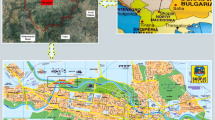Abstract
Factor analysis models are very attractive for source apportionment and have been widely applied. They do not require a priori knowledge of the number and composition of the sources, and they can actually uncover previously unsuspected sources and estimate the composition of the sources using only ambient monitoring data.
Aerosol particles were collected from an industrial atmosphere and analyses for water soluble and carbon components. Principal components analysis permitted the evaluation of the contribution due to industries, soil fraction, secondary pollutants and sea spray particles of the total suspended aerosol mass.
It can be concluded that the atmospheric aerosol in the Industrial Area of Estarreja (Portugal) contains a relative important fraction that is water soluble. Ammonium sulphates and nitrates are the main components of this fraction. Carbon compounds constitute about 30% of the total aerosol mass. These compounds are mainly formed by organic matter emitted by the industries. Due to the mutagenic and carcinogenic characteristics of some organic compounds processed in the Industrial Area (vinyl chloride, benzene, aniline, etc.), the concern exists of negative human health effects as a result of prolonged inhalation. Soil compounds is another important fraction of the aerosol mass, mainly in summer with dry, sunny and windy weather conditions.
A more conclusive idea of the sources and effects of aerosol matter can only be obtained with the specific analysis of organic compounds and the determination of trace elements, characteristic of each particular source.
Similar content being viewed by others
References
BrossetC. and FermM.: 1978, ‘Man-Made Airborne Acidity and its Determinations’, Atmos. Environ. 12, 909–16.
CleggS. L. and BrimblecomeP.: 1985, ‘Potential Degassing of Hydrogen, Chloride from Acidified Sodium Chloride Droplets’, Atmos. Environ. 19, 465–70.
CooperJ. A. and WatsonJ. G.Jr.: 1980, ‘Receptor Oriented Methods of Air Particulate Source Apportionment’, J. air Pollut. Control Assoc. 30, 1116–25.
HarrisonR. M.: 1983, ‘Ambient Air Quality in the Vicinity of a Works Manufacturing Sulphuric Acid, Phosphoric Acid and Sodium Tripolyphosphate, The Sci. Total Environ. 27, 121–31.
HenryR. C. and HidyG. M.: 1979, ‘Multivariate Analysis of Particulate Sulphate and Other Air Quality Variables by Principal Components—Part. I. Annual Data from Los Angeles and New York’, Atmos. Environ. 13, 1581–96.
JustoM. J.: 1984, ‘Corrosão e Protecção de Materiais’, LNETI 3, 15–21.
Kleinman, M. T., Pasternack, B. S., Eisendud, M., and Kneip, T. J.: 1980, ‘Identifying and Estimating the Relative Importance of Sources of Airborne Particles’, Environ. Sci. Technol. 62–5.
Martins, J. M.: 1983, Internal Project Report, Departamento de Ambiente, Universidade de Aveiro.
Sexton, K., Liu, K., Hayward, S. B., and Spengler, J. D.: Characterization and Source Apportionment of Wintertime Aerosol in a Wood-Burning Community, Atmos. Environ. 19, 1225–36.
WolfG. T., KorsogP. E., KellyN. A., and FermanM. A.: 1985, ‘Relationships Between Fine Particulate Species, Gaseous Pollutants and Meteorological Parameters in Detroit’, Atmos. Environ. 19, 1341–9.
Author information
Authors and Affiliations
Rights and permissions
About this article
Cite this article
Borrego, C., Pio, C.A. Statistical methods to apportion the sources of particles in the industrial region of Estarreja—Portugal. Environ Monit Assess 17, 79–87 (1991). https://doi.org/10.1007/BF00399294
Issue Date:
DOI: https://doi.org/10.1007/BF00399294




